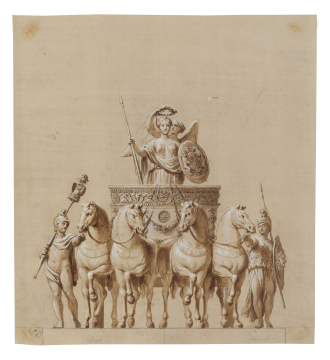
Browse
Reference number
Purpose
Aspect
Inscribed
Signed and dated
- Undated, probably 1762-63
Medium and dimensions
340 x 312
Hand
Notes
The rather wooden quality of the drawing and lack of action make this composition different from the rest of the set and hence the possible attribution to Giuseppe Manocchi (c.1731-82) or to Agostino Scara (see also Adam vol.7/38) of whom James Adam wrote that he '... draws figures full as well as Brunias, is simple and modest, not ambitious, good natured and will soon become skilled in the ornamental way' (Fleming, op.cit. p.279). In his essay of 1762, James Adam discussed the problem of scale, noting that: 'To avoid this in some measure I myself have followed an idea of the ancients and have placed on the top of a high pediment a figure in a triumphal chariot drawn by four horses' (Fleming, op.cit., p.318). This composition is probably inspired by the quadriga relief of Marcus Aurelius in the Palazzo dei Conservatori, Rome. There is a drawing for the chariot of the quadriga in Adam vol.7/107 and it is shown in the later elevation of the Parliament building in Adam vol.28/2. In Adam vol.7/73 there is an unfinished design showing a similar chariot drawn by six horses, which has similar pencil guidelines.
Literature
Level
Exhibition history
Sir John Soane's collection includes some 30,000 architectural, design and topographical drawings which is a very important resource for scholars worldwide. His was the first architect’s collection to attempt to preserve the best in design for the architectural profession in the future, and it did so by assembling as exemplars surviving drawings by great Renaissance masters and by the leading architects in Britain in the 17th and 18th centuries and his near contemporaries such as Sir William Chambers, Robert Adam and George Dance the Younger. These drawings sit side by side with 9,000 drawings in Soane’s own hand or those of the pupils in his office, covering his early work as a student, his time in Italy and the drawings produced in the course of his architectural practice from 1780 until the 1830s.
Browse (via the vertical menu to the left) and search results for Drawings include a mixture of Concise catalogue records – drawn from an outline list of the collection – and fuller records where drawings have been catalogued in more detail (an ongoing process).

